
Where did all the over-50s teachers go?

In 2010, there were 122,000 teachers over the age of 50 in England, accounting for just over a quarter of the workforce.
Fast-forward to the present day and that number has decreased by 25,000, meaning only one in five teachers is over the age of 50.
That’s a lot of experience that has disappeared from classrooms, staffrooms and senior teams.
So, what’s going on? Why have we lost so many experienced teachers and should we be concerned?
How many teachers are we talking about?
First, it’s worth understanding exactly how dramatically the situation has changed - something the table below illustrates clearly.

This shows that the workforce in England has grown younger, with the number of teachers over 50 becoming squeezed out at the top.
James Zuccollo, director for school workforce at the Education Policy Institute (EPI), thinks this is a big concern.
“Losing older teachers is a serious problem for education,” he tells Tes. “So much focus on retention has been about early career teachers, and retention for experienced classroom teachers has been left unexplored.”
So, why did so many leave, especially in the first half of the decade?
Jack Worth, workforce lead at the National Foundation for Educational Research (NFER), explains: “The decrease in the number of teachers over 50 can partly be explained because there was a big cohort of teachers over 50 who, in 2010, were approaching retirement.”
He adds: “A steady increase in the leaver rate in the early 2010s coincided with an increase in workload and was a period of increased policy change when a new curriculum and assessment system came into force.”
Worth suspects that the piling on of pressure pushed more older teachers out of the classroom door.
“More teachers than usual decided at that point [in the early 2010s] that they had had enough of teaching and this may have particularly been the case for teachers over 50 as they were approaching retirement anyway.”
The fact that the leaving rate slowed and then stagnated suggests this issue has passed. However, pension reforms that led to changes in the way workers both accrued and could access their pensions have actually made it less attractive to retire.
Specifically, Simon Rake, head of education at Wesleyan Financial Service, who advises teachers on their pensions, explains that the Teachers’ Pension Scheme’s switch from final salary calculated benefits to career average would actually be an incentive for over-50s to stay in the profession to ensure they are making the most of the TPS pension.
Indeed, data for the past five years makes it clear that more teachers are just leaving the profession rather than retiring from it.
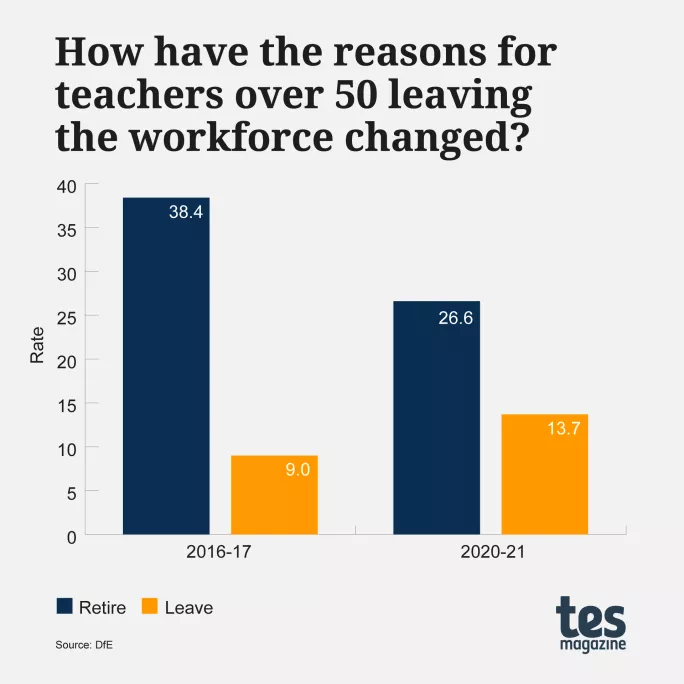
Despite this, the over-50s age group has been by far and away the most likely to leave over the past few years, as the below table shows.
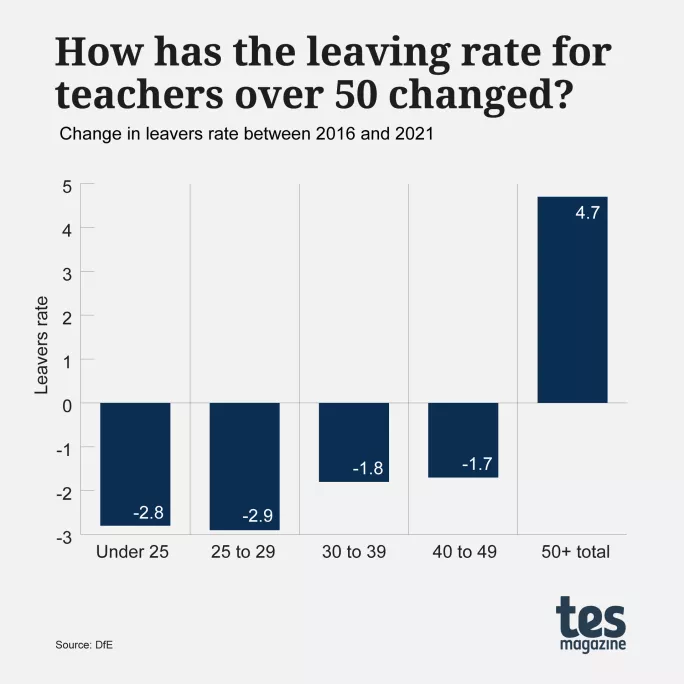
So, what’s making over-50s leave?
One suggestion is that teachers over 50 aren’t getting the promotional opportunities younger teachers get. If you haven’t already reached senior leader status by the time you reach 50, statistically, the likelihood is that you won’t.

The NASUWT teaching union says it has received reports of teachers over 50 being overlooked for promotions and new jobs. Not only that but the union also says it has had complaints that older teachers are “disproportionately threatened with capability procedures by their employers”.
Responses to its Big Question Survey 2023 from members over 50 revealed nearly three-quarters of teachers have seriously considered leaving the profession during the past year as a result of these factors.
Patrick Roach, general secretary of the NASUWT, calls it a “waste of valuable talent, knowledge and experience” and says that the loss of teachers over 50 is “further deepening the teacher recruitment and retention crisis”.
Ian Hartwright, senior policy adviser at the NAHT school leaders’ union, is equally damning, saying the numbers make it clear that the classroom is no longer an appealing place to work.
“England struggles to retain teachers as their career progresses as it does not offer a compelling proposition for a decades-long career in education,” he argues.
“Experienced teachers’ and school leaders’ pay has fallen in real terms by around a fifth since 2010, while crushing workload and high-stakes hit-or-miss inspection are together harming staff wellbeing.”
Lisa-Maria Müller, who is head of research at the Chartered College of Teaching and has been involved in research in this area, agrees “linear models of career stages” can be limiting and mean older teachers “lose their energy and enthusiasm [for teaching]”.
As the research she was involved in noted, this means more needs to be done to think about how to meet their needs and ensure they remain in the profession for longer.
“While typically confident in their practice, their learning needs vary and are often experienced as unmet, especially for those looking for progression routes outside leadership and those with family commitment,” the research noted.
“This indicates that their potential for career development to benefit the profession may not be reached.”
Flexible working options
The NFER’s Worth agrees and says flexible working is an area that “needs addressing” for older teachers to help more of them stick around and balance their working lives with later-life desires, such as by working in more part-time roles.
”A high proportion of teachers over 50 work part time, and there is likely also to be some unmet demand for part-time working among older teachers,” he says. “They may leave as a result of not being able to arrange part-time work.”
The Department for Education says it is promoting flexible working as part of a wider effort to ensure education is an attractive profession for all age groups.
“We are promoting flexible working in schools to ensure that teaching suits employees at different stages of their life and there are several programmes in place to recruit and retain excellent teachers from all backgrounds,” a DfE spokesperson says.
And as we explored on Tes recently, there are many schools and trusts that are starting to experiment with new and innovative flexible working approaches that may help more teachers over 50 balance later life demands and activities with a job in education.
Is this a problem everywhere in England?
While the broader trend has been a drop in the number of teachers over 50 followed by a plateau, it is worth noting that the decline has not been even across England.
As the map below shows, northern regions are now home to the fewest teachers over 50.
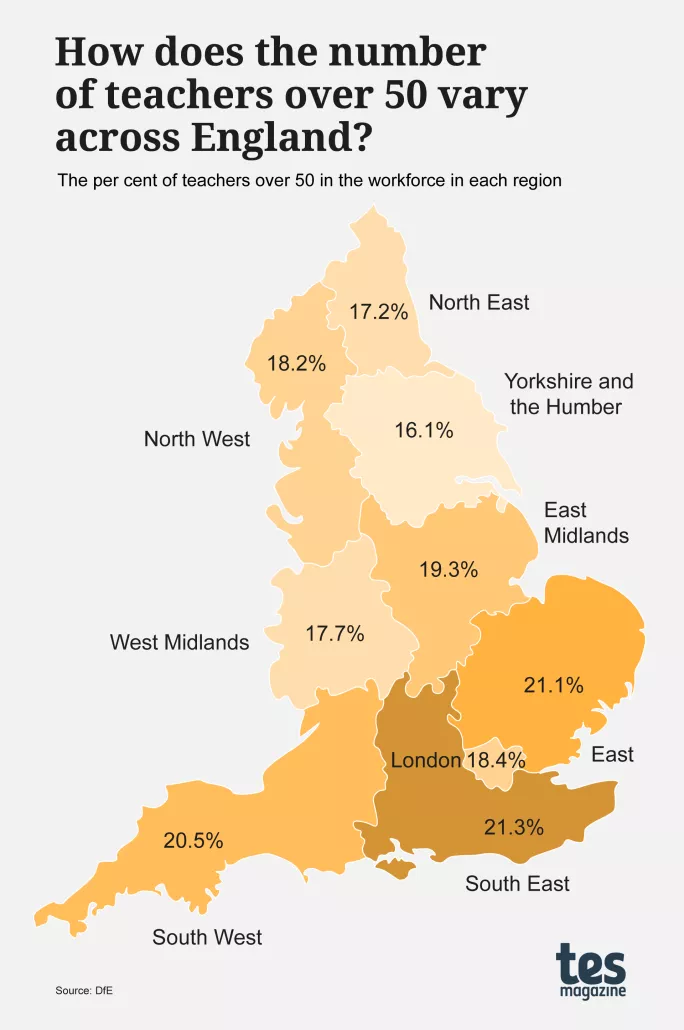
The regional pattern is the same in both primary and secondary schools, with figures in the North East and Yorkshire and the Humber being particularly notable.
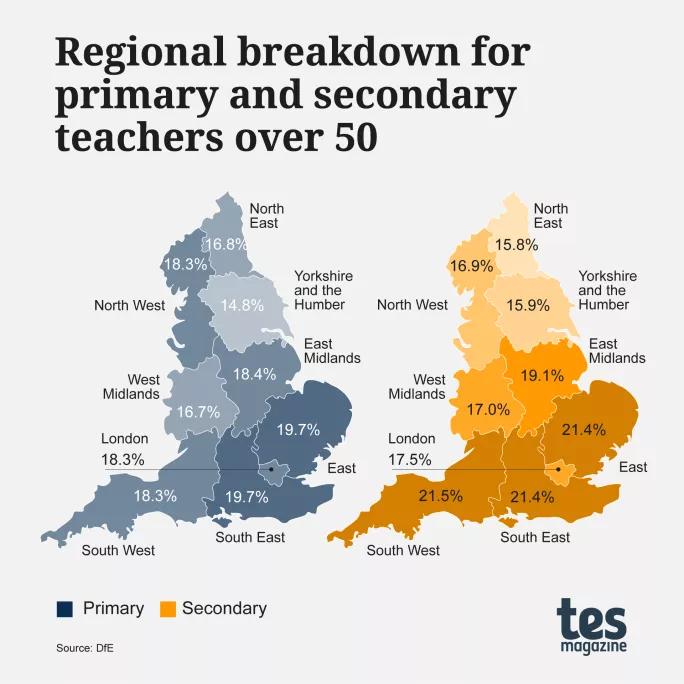
There isn’t any research to explain the difference between the numbers in the North and the South of England, but a spokesperson from the Department for Work and Pensions tells Tes that a smaller proportion of over-50s are employed in the North East than in the South East and the South West, so it is not a situation unique to teaching.
Nevertheless, Jonny Uttley, CEO of the Education Alliance Trust, which runs schools in Hull and East Riding of Yorkshire, says he feels the differences underline the tougher working conditions in the North of England compared with the South.
“It’s well known that the North of England has high levels of deprivation and that is a challenging prospect for teachers in schools,” he says. “Teaching is a demanding job, both physically and mentally. This must contribute to the difference in numbers.”
Recent data on suspensions and exclusions adds weight to this, with northern regions the highest on both counts, suggesting tougher conditions may cause many to decide to leave the profession in their later careers.
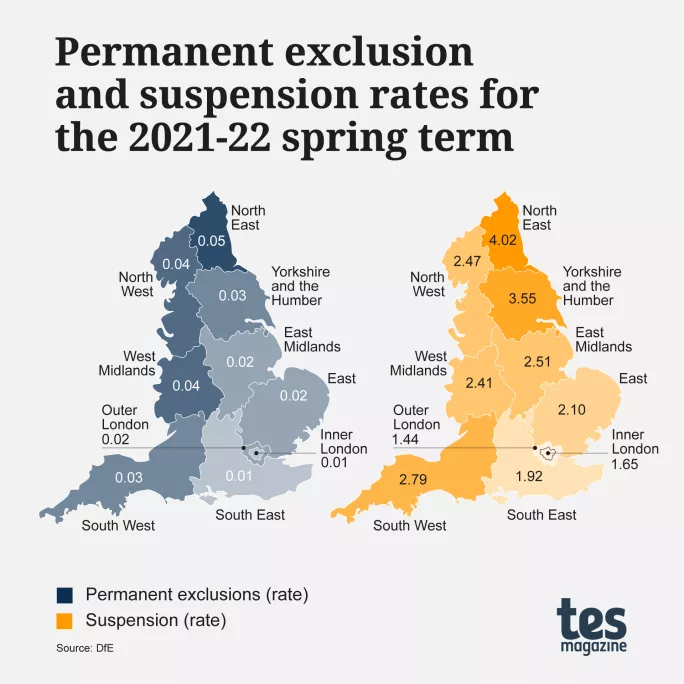
Meanwhile, Zuccollo from the EPI adds that with fewer vacancies in the North, many teachers may find it harder to find another job and so instead leave the profession altogether.
He says: “Because there are fewer vacancies and consequently fewer options for teachers who are unhappy at their school, teachers in the North and North East will leave the classroom altogether if they become unhappy at their school.”
What about the rest of the world?
Zooming out from a regional perspective to a European one, it is interesting to note that the Organisation for Economic Cooperation and Development (OECD) data shows this problem of a decline in teachers over 50 is particularly pronounced in the UK* compared with other nations.
*Although the UK figures include data for Wales, Scotland and Northern Ireland, England has by far the largest workforce of the four nations.
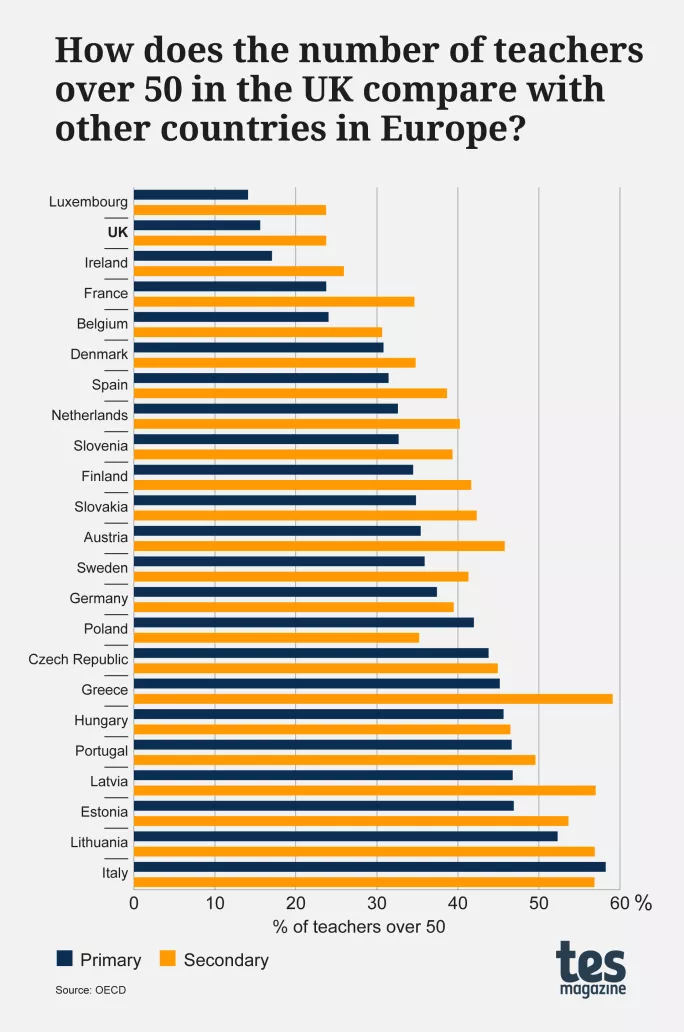
Not only that, but if we look at other G7 nations, the UK again has a far lower proportion of teachers over the age of 50.

Further data from the OECD in September 2023 shows that just 18 per cent of the teacher workforce in the UK is over 50 compared with an OECD average of 39 per cent.
International comparisons for workplace stress are also important to consider, says the NFER’s Worth.
“The OECD Teaching and Learning International Survey shows that, as well as being the youngest workforce, teachers [in the UK] have low job satisfaction, high stress and higher intentions to leave than other countries,” he says. “Our low level of retention, therefore, likely explains the young workforce: our workforce model relies on recruiting lots to replace those leaving, more so than other countries.”
Clearly, then, pay and working conditions for teachers in later life are not proving attractive enough. Given that recruitment for new teachers remains well below the targets being set by the government, how long this situation can persist remains to be seen.
As a silver lining, though, the impact of all the above means we don’t have the same concern as nations in the European Union, where the worry is that too many older teachers are still in the classroom and what will happen as they all reach retirement.
Too valuable to lose
Overall, it is clear that, in England, we have lost many skilled teachers over the past decade and many more join them in leaving each year. This means valuable talent is being lost from the classroom at a time when it is needed more than ever.
Perhaps we should end with a positive, though, by noting that the number of over-50s in the classroom has stabilised since 2019 and actually grew slightly in the most recent data - even if that was simply due to the pandemic interrupting people’s later life plans.
The DfE’s workforce report says that “the particularly low” rates of teachers leaving “is believed to have been impacted by the Covid-19 pandemic changing career plans for some people”.
As such, all eyes will be on the next update of the teacher workforce later in the summer to tell us if the number of over-50s grows or declines.
For schools on the front line, though, they will already be feeling this loss and the problems it causes. Not least because, as Zuccollo says, losing someone with decades of experience from your organisation is never a good thing.
“Teachers improve as they spend longer in the classroom, and this can’t be easily replaced by sending a less experienced teacher on a short training course,” he says. “When a teacher over 50 leaves, no one you replace them with can match their years of experience in the classroom.”
This article was first published on 5 May 2023
You need a Tes subscription to read this article
Subscribe now to read this article and get other subscriber-only content:
- Unlimited access to all Tes magazine content
- Exclusive subscriber-only stories
- Award-winning email newsletters
- Unlimited access to all Tes magazine content
- Exclusive subscriber-only stories
- Award-winning email newsletters
You need a subscription to read this article
Subscribe now to read this article and get other subscriber-only content, including:
- Unlimited access to all Tes magazine content
- Exclusive subscriber-only stories
- Award-winning email newsletters
- Unlimited access to all Tes magazine content
- Exclusive subscriber-only stories
- Award-winning email newsletters
topics in this article



